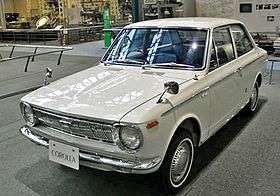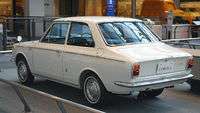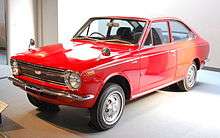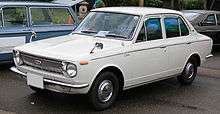Toyota Corolla (E10)
The Corolla E10 was the first generation of cars sold by Toyota under the Corolla name.

| Toyota Corolla (E10) | |
|---|---|
 Toyota Corolla (E10) 2-door Sedan | |
| Overview | |
| Production | November 1966–April 1970[1] July 1968–unknown (Australia)[2] |
| Assembly | Takaoka Plant, Toyota City, Japan Port Melbourne, Victoria, Australia |
| Designer | Tatsuo Hasegawa |
| Body and chassis | |
| Body style | |
| Layout | FR layout |
| Powertrain | |
| Engine | |
| Transmission | 4-speed manual 2-speed A20 automatic |
| Dimensions | |
| Wheelbase | 2,285 mm (90.0 in) |
| Length | 3,845 mm (151.4 in) |
| Width | 1,485 mm (58.5 in) |
| Height | 1,380 mm (54 in) |
| Chronology | |
| Predecessor | Publica |
| Successor | Corolla E20 |
The Corolla was launched in Japan in November 1966 at a Japanese dealership sales channel called Toyota Corolla Store. Eiji Toyoda said it took hard work to create popular demand, and disputed that Toyota rode a wave of private car ownership that was taking off in the mid-1960s. The Corolla's major competitor was the Datsun 1000, released a few months earlier, along with the Subaru 1000 earlier in May. Its companion, the Toyota Sprinter, was sold at a different dealership sales channel called Toyota Auto Store. The Corolla's development was largely influenced by the success and lessons learned from an earlier, smaller vehicle called the Toyota Publica, which used an air-cooled two-cylinder, boxer-style engine, inspired by the Citroën 2CV. The dealership that was named after the Corolla in Japan was previously known as the Toyota Public Store, to sell the Publica.
Design
The initial car, the KE1x series was small, with a 90 in (2286 mm) wheelbase. The transmission was by a four-speed floor shift manual transmission or a two-speed floor or column shift automatic transmission, with rear wheel drive. At the time, floor shift transmissions were considered only for trucks and four speeds implied that the engine did not have enough torque to drive through only three gears (more torque allows each gear to have a wider spread of engine revolutions, thus requiring fewer gears). This was a big risk for Toyota but the effectiveness of the new system gained in popularity.
The suspension in front was MacPherson struts supported by a transverse leaf spring beneath the engine cross-member, with leaf springs connected to a solid axle in back.
The engine was originally meant to be for the under 1000 cc tax class but was changed late in the design process to be 1077 cc in order to beat the forthcoming Datsun 1000. In Japan, this put it into a 1000cc engine road tax class but gave it some prestige over the Datsun 1000 - helped by its "100 cc advantage" advertising campaign. In May 1967 a four-door sedan (KE10F) and a three-door light van (KE16V, essentially a station wagon but classified as a light commercial vehicle in Japan) joined the lineup, as did the "Toyoglide" two-speed automatic.
In March 1968 the range got a facelift, mostly safety upgrades to reflect new American legislation. Since the beginning of the Corolla, Toyota has dependably facelifted each generation after two years and replaced it with an all-new model every four years. The dashboard was now padded and used non-reflective glass, while the front bumper was mounted somewhat higher. Also new were a four-speed column-shift option and the better equipped Corolla SL two-door sedan, using a twin carburetted K-B engine and an extra 13 PS (9.6 kW).[3] The K-B engine was not available with a column shift. In early April the "Corolla Sprinter" coupé, using the SL's more powerful engine, was introduced.[4] In August 1968 Thai Hino Industry began assembling the Corolla locally; this was the first Corolla to be produced outside of Japan.[5]
In August 1969 the engine was upgraded to 1166 cc. A special twin carburettor 3K-B (1166 cc) engines was again used in the SL and Sprinter models.
Japan
Japanese market engines:
- K — 1.1 L (1077 cc) I4, 8-valve OHV, carb, 60 PS (44 kW)
- K-B — 1.1 L (1077 cc) I4, 8-valve OHV, twin carb, 73 PS (54 kW)
- 3K — 1.2 L (1166 cc) I4, 8-valve OHV, carb, 65 PS (48 kW)
- 3K-B — 1.2 L (1166 cc) I4, 8-valve OHV, twin carb, 78 PS (57 kW)
Japanese market chassis:
- E10 — 1077 cc Sedan (2-door/4-door)
- E15 — 1077 cc Coupé
- E16V — 1077 cc Van, 3-door
- E11 — 1166 cc Sedan (2-door/4-door)
- E17 — 1166 cc Coupé
- E18V — 1166 cc Van, 3-door
North America
Exports to the United States began in March 1968 at about US$1,700.
North American market engines:
- K — 1.1 L (1077 cc) I4, 8-valve OHV, carb, 60 hp (44 kW)
- 3K — 1.2 L (1166 cc) I4, 8-valve OHV, carb, 65 hp (48 kW)
North American market chassis:
- E10 — 1077 cc Sedan (2-door/4-door)
- E15 — 1077 cc Coupé
- E16 — 1077 cc Wagon, 2-door
- E11 — 1166 cc Sedan (2-door/4-door)
- E17 — 1166 cc Coupé
- E18 — 1166 cc Wagon, 2-door
Australia
The first export market for the Corolla was Australia from November 1966. Australia received right hand drive versions of the same models as America. Local production commenced in July 1968.[2]
Gallery
 Corolla (E10) 2-door Sedan
Corolla (E10) 2-door Sedan Corolla Sprinter (E10)
Corolla Sprinter (E10) Corolla (E10) 4-door Sedan
Corolla (E10) 4-door Sedan.jpg) Corolla (E10) Wagon (facelifted model)
Corolla (E10) Wagon (facelifted model)- Corolla Van Deluxe (KE18, JDM)
_Front_Right_Fender_Badge.jpg) Front right fender badge
Front right fender badge
References
- Toyota Vehicle Identification Manual. Japan: Toyota Motor Corporation - Overseas Parts Department. 1984. Catalog No.97913-84.
- "Overview of Overseas Production Affiliates:Oceania". Toyota Motor Corporation. 2012. Retrieved 2014-07-11.
- "トヨタ自動車販売(株)『モータリゼーションとともに. 資料』(1970.11)" [Toyota Motor Sales Co., Ltd. "With Motorization" document (1970.11)]. Shibusawa Shashi Database (in Japanese). Shibusawa Eiichi Memorial Foundation. p. 137. Archived from the original on 2020-01-07.
- Shibusawa Shashi Database, p. 138
- Shibusawa Shashi Database, p. 141
| Wikimedia Commons has media related to Toyota Corolla (E10). |